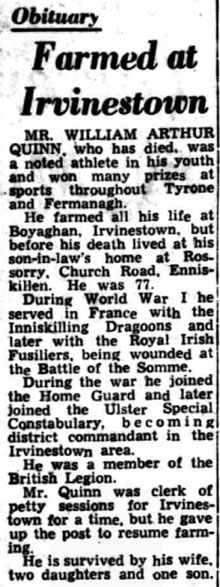Company Quartermaster Sergeant William Arthur Quinn
William Arthur Quinn was born on 11 November 1890 at Drummal, County Fermanagh, the first of seven children of clerk (later land agent) William Quinn and his wife National School teacher Anna Bella (nee Cathcart). By 1911 Quinn was living with his family at Drumarky, near Lisnarick, County Fermanagh, and working as a farmer.
Quinn enlisted in the 6th (Inniskilling) Dragoons Service Squadron between 6 and 10 October 1914 (No. UD/18).
He embarked for France with his squadron on 6 October 1915. At the time the squadron was serving as divisional cavalry to the 36th (Ulster) Division. According to the squadron war diary, from 12 to 17 October Sergeant Quinn and Captain Hulse attended a bombing class. On 26 January 1916 the diary noted that:
2/Lieuts Matthews & McWilliam, Sergt Quinn & Lce Sergt Reid proceeded to the Div. School of Instruction at Le Meillard.
In June 1916 the Inniskilling squadron came together with C and F Squadrons of the North Irish Horse to form the 2nd North Irish Horse Regiment, serving as corps cavalry to X Corps until August 1917. On 5 July 1916, while engaged on salvage duty at Aveluy Wood, Quinn was wounded when his party came under heavy artillery fire. The regimental diary stated:
Orders were received from A.P.M. 36th Division at 9 am for the two troops dismounted to report to Capt O'Neill at Lancashire Dump for salvage duty. They carried out this duty bringing in equipment, rifles etc till 1 pm. The men had dinner and were just turning out again when Lieut Seymour received orders from 36th Division to return to Regtl Head Quarters. The men had just started to saddle up when a heavy bombardment of both high explosive, shrapnel & machine guns was concentrated on the Wood. The intensity of the fire necessitated Lt Seymour giving orders for the men to take shelter in some old dugouts & trenches close by. The bombardment lasted for 3/4 of an hour & then slackened but did not entirely stop. Up to now one horse was killed & four wounded. The men were then ordered to saddle up & lead their horses thro' Wood out on to the road and were waiting for the others to join up when the bombardment opened much heavier than previously especially on that part of the road where the men were waiting. Lt Seymour moved off up the road leaving 2/Lt Matthews & Sergt McIlvoy to round up the stragglers in the wood, as by this time horses were very restive and almost unmanagable. Lt Seymour with his party had reached about 1 mile along the road & turned down a lane leaving the horses in charge of Sergt Quinn. Almost immediately a heavy fire was brought to bear on the horses and Sergt Quinn was wounded. The horses stampeded in every direction, some back to Aveluy Wood. Eventually Lt Seymour was able to round up most of this party & got to Senlis. Lieut Matthews & Sergt McIlroy remained behind. Our losses numbered 16 horses killed or wounded and 2 missing. 2/Lt Matthews was wounded severely in the knee from high explosive and Pte Downes, Nicholl, Gourley wounded (hosp) and Ptes Buchanan, 195 Campbell, Totton, 105 Craig, Cpl Dickson, 209 Robinson slightly wounded (duty).
In September 1917 the 2nd North Irish Horse Regiment was dismounted and most of its men transferred to infantry. The majority, including Quinn, were transferred to the 9th (Service) Battalion, Royal Irish Fusiliers, on 20 September. The battalion was renamed the 9th (North Irish Horse). Quinn was issued a new regimental number – 41097. As he had been acting squadron quartermaster sergeant, Quinn was made acting company quartermaster sergeant in the new battalion. He was later confirmed in that rank.
Quinn was transferred to Class Z, Army Reserve, on 3 March 1919.
He died at Enniskillen on 11 December 1967.

Belfast Telegraph, 22 December 1967
This page last updated 14 January 2023.
.
